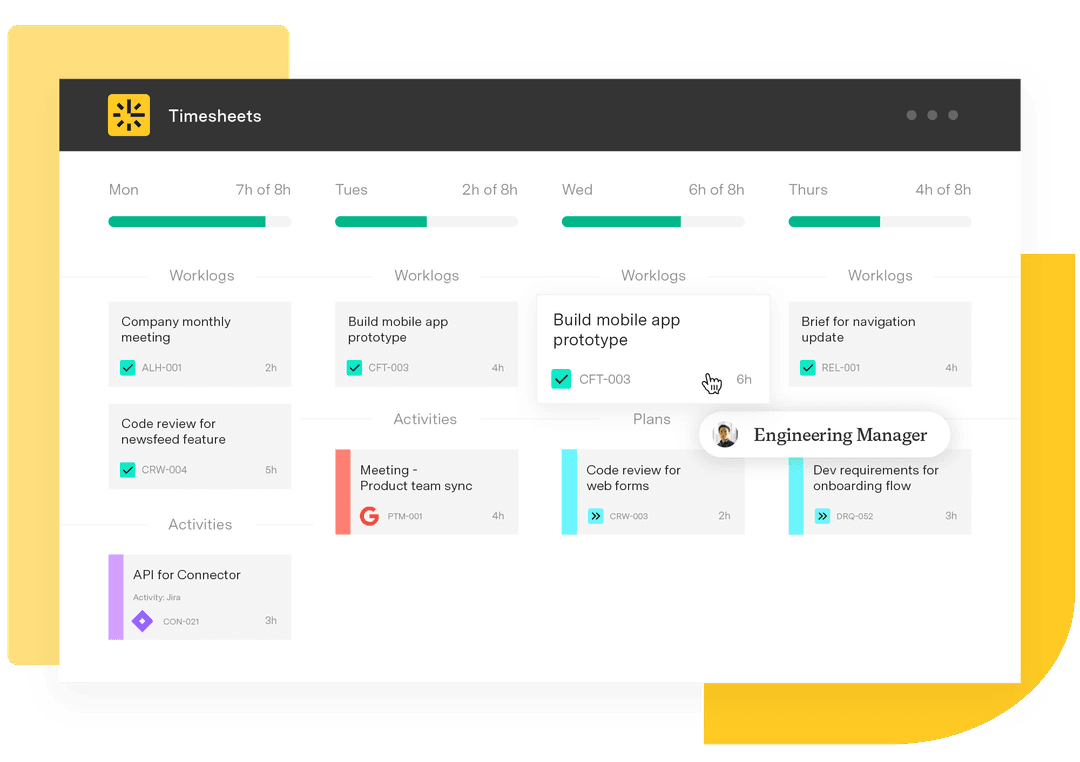7 strategies for effective project contingency planning
Tempo Team
Every project begins with a plan, but even the most carefully scoped timelines and budgets are sometimes disrupted by unforeseen challenges. That’s why effective project managers don’t just focus on execution – they prepare for uncertainty.
A project contingency plan helps teams manage risks before they escalate. It’s a key part of strategic planning that supports flexibility, stakeholder confidence, and successful delivery.
In this article, we’ll define project contingency, explain when and how to build a plan, and highlight how Tempo helps teams stay in control when things shift.
What’s project contingency?
Project contingency refers to allocating extra resources to address potential risks that may arise during a project. These contingencies act as a buffer that can absorb the impact of disruptions without derailing the overall project timeline.
In simple terms, having contingencies in project management allows teams to stay on track even when unexpected issues occur. Whether it’s a supplier delay or a scope change, planning for likely risks ensures your team is ready to respond quickly. This ability to pivot is vital in enterprise environments where the cost of delays can be significant. For example, if a major logistics company is on track to ship a new product but a distributor goes out of business, a project contingency would include backup distributors on file.
Creating a contingency plan in 7 steps
A strong contingency plan provides clear guidance on what to do when risks materialize. Here are the essential steps to build one.
1. Identify potential risks through analysis
Begin by examining all phases of the project for areas of uncertainty. Conduct risk assessments and consult stakeholders to uncover potential crisis triggers. Once you’ve identified the most immediate threats, log them in a risk breakdown structure, categorizing them by types such as:
Technology
Interface
Performance
Logistics
Budget
2. Assess the likelihood and impact of each risk
Use qualitative or quantitative methods for risk assessment to evaluate the likelihood of each risk and the damage it could cause. This step helps your team prioritize which risks need immediate contingency planning.
3. Determine appropriate buffers
Based on the risk analysis, define specific buffers for time, budget, or scope. For example, a project might include an additional two weeks to accommodate unexpected delays or a 10% budget contingency to address cost overruns.
4. Define triggers for activating contingencies
Contingency plans shouldn’t be used at the first sign of trouble. Instead, clearly define conditions or thresholds that signal to a project manager when a contingency plan must be implemented.
5. Allocate resources specifically for contingencies
Make sure that the resources set aside for contingencies are tracked and protected. These allocations shouldn’t be reallocated to other project needs unless risks have been safely retired.
6. Document procedures and responsibilities
Outline who is responsible for executing contingency plans and what the process looks like. Clear documentation helps teams act quickly and with confidence.
7. Regularly review and update the plan
As a project evolves, so does risk. To ensure the contingency plan stays relevant, make it a recurring part of project reviews. In addition, examine your professional development resources to bolster your team’s ability to respond to threats in the future.
When to use a contingency plan
Not every project phase will need contingency action. However, some scenarios are especially high-risk. Here are common situations when a contingency plan becomes essential:
When significant risk is identified during planning: Some projects carry known risks from the start, such as tight deadlines, limited staffing, or untested technology. In these cases, building contingencies into the plan proactively protects critical paths and avoids cascading delays.
When scope or technical requirements aren’t yet well defined: The full scope may be ambiguous in early-stage projects. This uncertainty can lead to shifting requirements, rework, or additional time to finalize specifications. Contingency planning helps absorb the impact of scope creep or unforeseen complexities.
When project phases rely on external dependencies or suppliers: Third-party vendors, contractors, or hardware providers introduce risks outside your team’s control. A supplier delay or contract dispute can stall progress – unless you’ve built in a contingency like a backup vendor or alternative workflow.
When critical milestones approach: The closer a project gets to delivery, the more difficult it becomes to change course. Luckily, activating a contingency plan at this stage helps protect final delivery – it means reallocating resources, adjusting priorities, or bringing in extra support.
If early warning signs or delays begin to surface: Monitoring tools like dashboards and time tracking often reveal risk signals before a crisis can arise. If team velocity slows, cost burn increases, or progress metrics flatten, it may be time to implement contingency actions to correct the course.
What’s a project contingency budget?
A project contingency budget is a portion of the total budget set aside to address unexpected costs. It provides financial flexibility to resolve issues without additional funding or approval processes.
Budget contingency includes monitoring usage and updating financial forecasts as risks are resolved. The amount varies by industry, but a common guideline is five to 10 percent of the total project budget.
The goal of a contingency budget isn’t to spend the entire sum, but to use it to preserve project continuity when and if something goes wrong. Teams should track how the budget is used to improve planning accuracy over time.
Contingency plan vs. mitigation plan
Though often used interchangeably, contingency plans and mitigation plans serve different purposes.
Mitigation plans are proactive. They aim to reduce the probability or impact of risks before they occur. For example, switching vendors early to avoid potential delays is a mitigation tactic.
Contingency plans are reactive. They describe how the team will respond if a risk becomes a reality. For example, a contingency plan might include a pre-approved backup supplier if a vendor fails to deliver.
Both approaches are important. Mitigation and contingency strategies used together form a more resilient project management strategy.
Strengthening contingency management with Tempo
A solid contingency plan is only effective when teams have the visibility and tools to act on it. Tempo’s suite of Jira-native solutions helps project teams maintain control by tracking the resources, time, and tasks associated with risk response.
Timesheets allows teams to log time spent on mitigation activities or contingency responses. This visibility lets project managers understand the true cost of risks and adjust their plans accordingly.
With Custom Charts and Strategic Roadmaps, teams can visualize project timelines and resource allocation. This insight makes it easier to spot early signs of trouble, evaluate buffer usage, and communicate risk status with stakeholders.
Instead of guessing how much contingency a project should have, Tempo gives teams the data they need to plan for success.











































